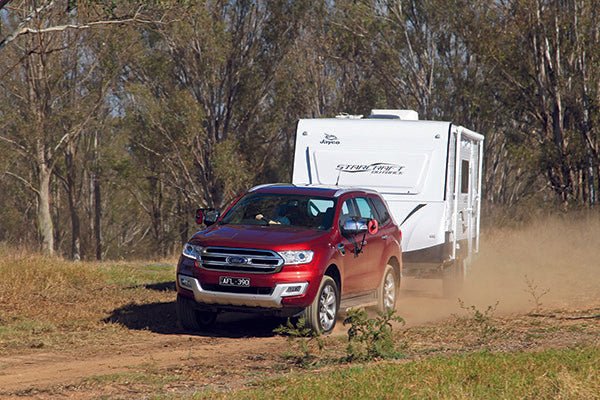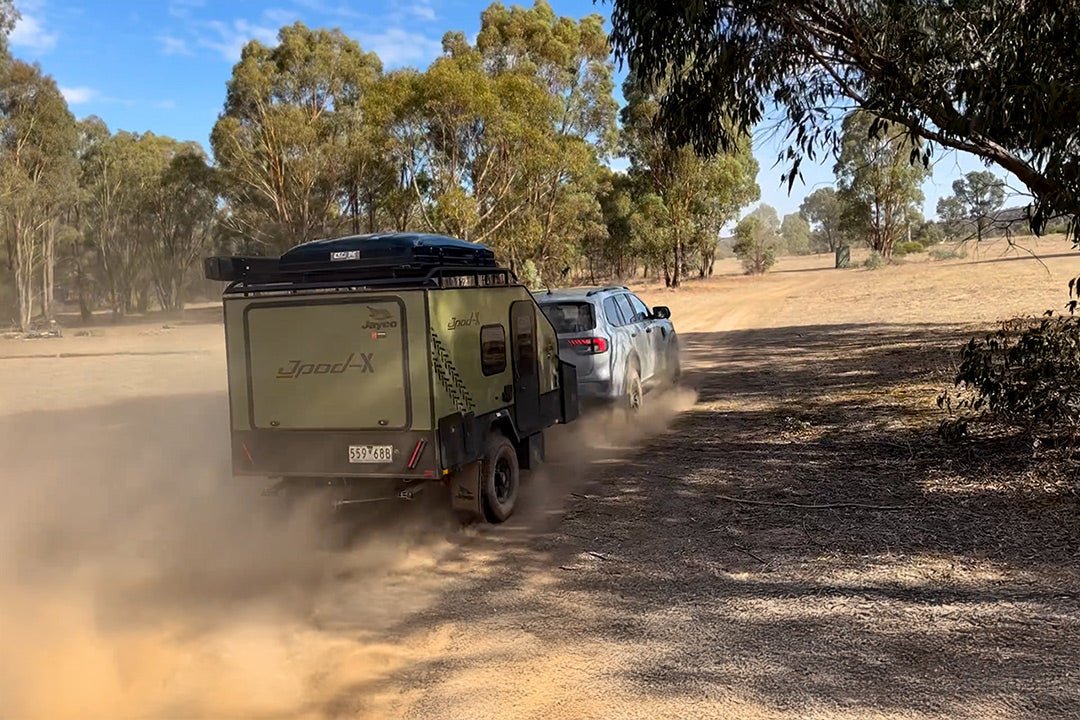Ford Everest Titanium Tow Test

The large offroad SUV segment has been busy with both new and refreshed models launched in the past 12 months. We’ve already tested the new Toyota Fortuner (CW 549) and Mitsubishi Pajero Sport (CW 552), and now we’ve had the chance to hitch up a van behind Ford’s new entrant, the Everest.
The Everest is based on the Ranger ute, so it has a body-on-chassis design, live rear axle, 3.2L five-cylinder turbodiesel and six-speed auto. The key difference with the Everest (aside from the obvious body change) is that the rear axle is suspended on coils in place of the Ranger’s heavy-duty leaf spring design and the 4WD system is torque-on-demand rather than the part-time system in the Ranger.
ATTRIBUTES
There are three Everest models: the entry-level Ambiente, mid-spec Trend and premium model Titanium. Each gets seven seats and all have an identical powertrain.
The Titanium we tested has a comprehensive driver-assist package, including adaptive cruise control (ACC) with forward collision alert, lane keeping and blind spot monitoring. The ACC cuts out at speeds below 30km/h, so obviously doesn’t have the useful stop-and-go feature that some vehicles with ACC have.
Other key Titanium features include auto on/off HID headlights with auto high beam control, power tailgate, rain-sensing windscreen wipers, sunroof and 20in alloy wheels. Inside, the Titanium has leather seats (heated at the front and with power adjustment for the driver’s seat), dual-zone climate control, rear air-conditioning, satnav and infotainment system, tyre pressure monitoring, and electric folding third-row seat. A couple of expected items that are absent from this list are keyless entry and start, and power adjustment for the front passenger seat.
As is typical of a body-on-chassis design, there’s a need to climb up on to the driver’s seat. But once ensconced in the supportive bucket, you’re presented with an instrument and control layout that is easy to use. Navigating through the infotainment menus is a cinch, too.
The second-row seats are flat – great for child seats – and the relatively low seat puts you in a slightly ‘knees-up’ position, leaving under-thigh support pretty sparse. The centre seat is firm but not so that you feel as though you’re sitting on a board, as you do in some vehicles. There is ample legroom across all three seats, with no tall transmission tunnel hump to contend with. Headroom is a bit tight for six-footers back here, though – a result of the sunroof which takes up some of the ceiling space.
There are ceiling air vents in the second and third rows, with temperature and fan speed controls on the back of the centre console. There is also a 230V/150W socket and a 12V socket on the console.
The third-row seats are perfect for sub-teens, and adults at a stretch, with the second-row seats racked forward on their fore-aft runners. Getting in and out of the third row is not difficult – except that the one-third seat split is on the offside. This means that, with a full second-row of passengers, two of them will have to get out to allow access to the third row from the (safer) nearside of the vehicle.
ENGINE AND TRANSMISSION
The 3.2L turbodiesel pulls away cleanly and shovels in the coals to give the mid-range a solid burst of steam. Going much beyond around 3500rpm is pointless (the transmission upshifts at around 4000rpm) as this is not a free-revving diesel like some are. The transmission has a good ratio spread and shifts are smooth.
With an on-demand 4WD system with Terrain Management and locking rear diff, the Everest looks promising for offroad work.
While having ACC makes cruising much more relaxing (though you can’t use it when towing), in this vehicle it’s not perfect. It’s late to react to slowing traffic in some situations and disengages at 30km/h so it can’t be used in slow traffic. It also became confused when overtaking a B-double on an open, right-hand curve on a dual-lane highway, hesitating as it ‘saw’ the B-double as potentially a vehicle in its own lane.
SUSPENSION
The Everest has an independent front suspension and a coil-spring, live axle at the rear, which is par for the course in this class. This is not the ideal setup for a supple ride, although the Everest does better than some in this class in its ability to dispatch bumps. Yet, like most live rear axle setups, the Everest is confounded by deeper corrugations, resulting in axle tramp and some skittishness.
While the six-spoke 20in wheels look impressive and the low-profile tyres grip well for a mud/snow pattern, the unsprung weight of such large wheels and the short tyre sidewalls don’t help ride quality over potholes and large bumps.
The Everest is better than many of its competitors when roping in a series of corners, the too light yet direct steering and good chassis balance making it a rewarding point-to-point tourer.
ECONOMY
The Everest achieved 9.2L/100km driving solo, most of which was done at 100km/h on the highway. Fuel consumption ramped up to 17.1L/100km when towing a 2325kg van. These figures are very good for a vehicle weighing 2.5t and with its fuel tank capacity you’ll easily get 400km down the road with an ample safety reserve of fuel.
TOWING
With its abundant torque, heavy mass and promising dimensions (long-ish wheelbase and quite short rear axle-to-hitchpoint measurement), the Everest should be a great tow vehicle. In practice, it wasn’t as planted on the road with a van behind as you might hope. The front-end pitching over undulating roads and occasional swaying were not confidence-inspiring. While this may be the net result of poor caravan balance (in that the van was at Tare, not loaded up with payload as it would be when touring), it didn’t seem to be because of excessive towball load. The suspension droop was 28mm at the rear, while the rise was just 7mm at the front, with the caravan’s 157kg towball mass.
Steaming up our 90km/h test climb, the Everest shaved 10km/h off its travelling speed. Engine braking was very good, even though the Everest doesn’t have the benefit of the steering paddle shifters that some of its competitors have. It does have a ‘sport’ mode – which makes the transmission more eager to downshift – and manual mode at the gear lever.
In the Everest’s safety suite is trailer sway control, which is a great safety net that all tow tugs should offer. Ford says that, when towing, speeds should not exceed 113km/h for the first 800km of the vehicle’s life and that the transmission should be put into ‘park’ when stopped in heavy traffic during hot weather to help the transmission stay cool and the air-conditioning to maintain its performance.
Another note for towing is that the side mirrors are quite large, which can make some towing mirrors a bit more difficult to attach.
THE BOTTOM LINE
The Everest is a spacious and generally well-equipped 4WD wagon that performs well and has good touring fuel economy. As a tow vehicle, it also acquits itself well in its engine performance and fuel economy. Towing stability was perhaps affected by too little ball load, which could explain its inclination to sway a little. On this sampling, it’s a good but not great, tow hauler.
Thanks to Jayco Sydney, Glossop Street, St Marys, NSW, (02) 9623 1971 for the loan of the caravan for this test.
The full article appears in Caravan World #553 July2016. Subscribe today for the latest caravan reviews and news every month!







